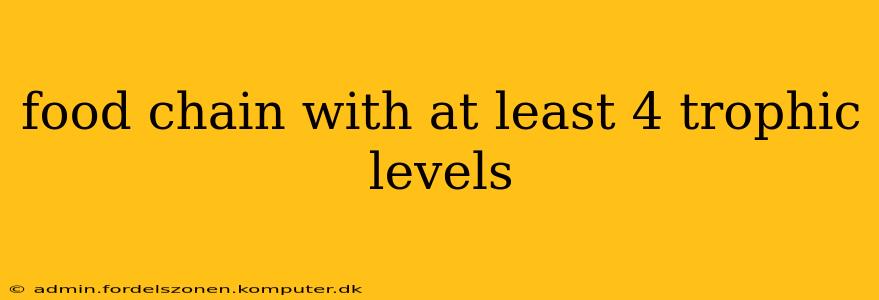Unveiling the Intricate Web: A Food Chain with at Least Four Trophic Levels
Understanding food chains is fundamental to grasping the delicate balance of ecosystems. While simplified representations often show fewer levels, complex food webs in reality boast multiple trophic levels, showcasing the intricate relationships between organisms. Let's explore a food chain with at least four trophic levels, illustrating the flow of energy and nutrients through an ecosystem.
What is a Trophic Level?
Before we dive in, let's define a trophic level. It represents the position an organism occupies in a food chain, indicating its feeding level. The levels typically progress as follows:
- Producers (Level 1): These are autotrophs, organisms that produce their own food, primarily through photosynthesis (like plants and algae).
- Primary Consumers (Level 2): These are herbivores, feeding directly on producers.
- Secondary Consumers (Level 3): These are carnivores or omnivores that prey on primary consumers.
- Tertiary Consumers (Level 4 and beyond): These are carnivores that feed on secondary consumers, often at the top of the food chain (apex predators).
Example: A Kelp Forest Food Chain
Let's examine a food chain found within a vibrant kelp forest ecosystem. This environment supports a rich array of life and provides an excellent example of a complex food chain with multiple trophic levels.
-
Producers (Level 1): Kelp (a type of brown algae). Kelp forms the base of this food chain, utilizing sunlight to photosynthesize and create energy.
-
Primary Consumers (Level 2): Sea urchins. These herbivores graze directly on the kelp, consuming significant amounts of this primary producer.
-
Secondary Consumers (Level 3): Sea otters. Sea otters are keystone species in kelp forests, preying on sea urchins and controlling their populations. Without sea otters, sea urchin populations can explode, devastating the kelp forest.
-
Tertiary Consumers (Level 4): Orcas (Killer Whales). While not exclusively feeding on sea otters, orcas are apex predators and can significantly impact sea otter populations, thereby influencing the entire food chain.
Other Examples and Considerations
This kelp forest example is just one illustration. Numerous other ecosystems display similar complex food chains. Think about:
- Grassland Food Chain: Grass (producer) -> Grasshopper (primary consumer) -> Frog (secondary consumer) -> Snake (tertiary consumer) -> Hawk (quaternary consumer).
- Forest Food Chain: Tree (producer) -> Deer (primary consumer) -> Wolf (secondary consumer) -> Bear (tertiary consumer).
Frequently Asked Questions (PAAs)
What happens if one trophic level is removed?
Removing a trophic level can have cascading effects throughout the entire food chain. For instance, the removal of sea otters (secondary consumers) in the kelp forest example would lead to an overpopulation of sea urchins, resulting in the destruction of the kelp forest and impacting all other organisms reliant on it. This highlights the interconnectedness of trophic levels and the importance of maintaining ecological balance.
Can a food chain have more than four trophic levels?
Yes, absolutely! Many food chains extend beyond four levels. The complexity of ecosystems often supports longer chains, with apex predators at the top feeding on multiple lower trophic levels. For example, some deep-sea ecosystems exhibit incredibly long food chains.
How does energy flow through a food chain?
Energy flows unidirectionally through a food chain, typically from producers to consumers. However, it's crucial to understand that energy transfer is not entirely efficient. Only a fraction of the energy consumed at each level is transferred to the next; much is lost as heat. This explains why food chains rarely have many levels, as the energy available decreases with each trophic level.
Are food chains static?
No, food chains are dynamic and constantly changing based on environmental factors, population fluctuations, and interactions between species. For instance, disease, climate change, or human intervention can drastically alter the structure and functioning of a food chain.
By understanding the structure and dynamics of food chains with multiple trophic levels, we gain a deeper appreciation for the complexities of ecosystems and the interconnectedness of life on Earth. The delicate balance of these systems highlights the importance of conservation efforts to protect biodiversity and maintain the health of our planet.
